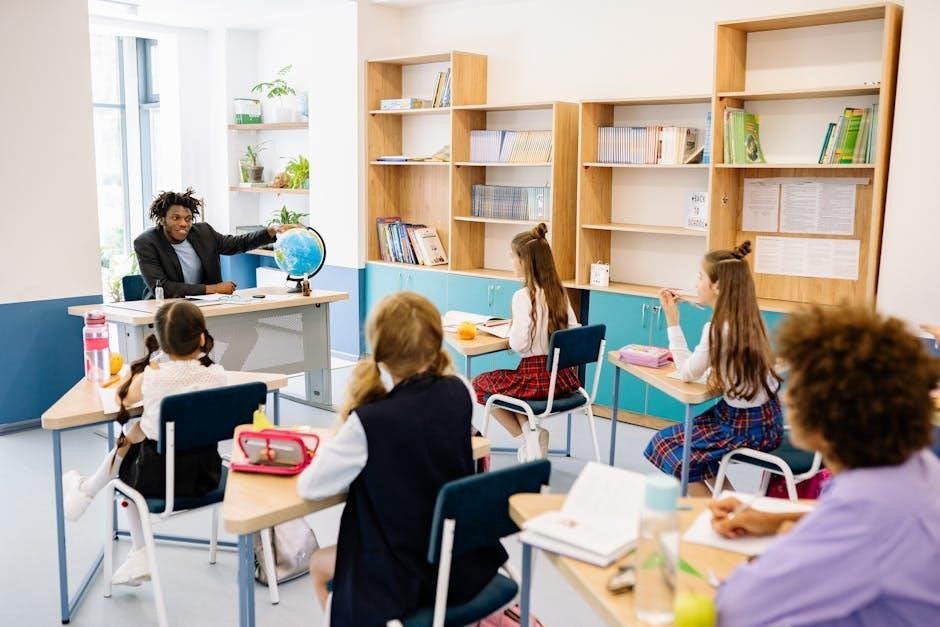Instructional Conversation in SIOP is a key component, involving meaningful interactions between teachers and students to enhance language development and critical thinking through structured dialogue.
1.1 Definition of SIOP (Sheltered Instruction Observation Protocol)
SIOP, or Sheltered Instruction Observation Protocol, is a research-based instructional framework designed to support English learners by making academic content accessible. It provides teachers with structured strategies to deliver lessons that integrate language and content learning, ensuring students develop both subject matter knowledge and language proficiency. SIOP emphasizes clear instruction, opportunities for interaction, and feedback to meet diverse student needs effectively.
1.2 Overview of Instructional Conversation in SIOP
Instructional Conversation in SIOP refers to a structured dialogue between teachers and students that promotes language development and academic understanding. It involves scaffolding techniques to make content accessible, fostering meaningful interactions, and encouraging critical thinking. This approach creates an inclusive environment where students can engage actively, share ideas, and build proficiency in both language and subject matter. It is a cornerstone of SIOP, ensuring students receive targeted support to meet their diverse learning needs effectively.
Key Components of Instructional Conversation
Instructional Conversation in SIOP involves teacher-student interactions, scaffolding, and structured dialogue, focusing on language development, critical thinking, and academic content understanding through collaborative engagement.
2.1 The Role of the Teacher in Facilitating Conversations
The teacher plays a central role in instructional conversations by creating opportunities for meaningful dialogue, guiding discussions, and encouraging critical thinking; Teachers pose open-ended questions, connect student ideas to academic content, and scaffold learning to ensure comprehension. They also provide feedback and model language use, fostering a supportive environment where students feel valued and motivated to participate. This facilitation helps students engage deeply with material, develop language skills, and build collaborative relationships.
2.2 The Role of Students in Instructional Conversations
Students play an active role in instructional conversations by engaging in meaningful discussions, sharing ideas, and applying prior knowledge. They participate by responding to open-ended questions, elaborating on thoughts, and collaborating with peers. Students learn to listen, reflect, and build on others’ contributions, fostering critical thinking and language development. Their involvement helps create a dynamic learning environment where they can articulate their understanding, explore concepts, and gain insights through dialogue and interaction. This active participation enhances their ability to communicate effectively and solve problems collaboratively.
2.3 Importance of Scaffolding in Instructional Conversations
Scaffolding is crucial in instructional conversations as it supports students’ learning by breaking tasks into manageable steps. Teachers provide temporary assistance, such as prompts or clarifications, to bridge knowledge gaps. This strategy ensures students can access content, develop language skills, and build confidence. By gradually reducing support, scaffolding enables students to take ownership of their learning, fostering independence and higher-order thinking. It aligns with SIOP principles, ensuring all learners, especially English language learners, can actively participate and succeed in academic discussions.
Techniques for Effective Instructional Conversations
Effective instructional conversations involve techniques like open-ended questioning, active listening, and encouraging peer interactions. These strategies promote engagement, critical thinking, and language development among students.
3.1 Using Open-Ended Questions to Encourage Critical Thinking
Open-ended questions in instructional conversations prompt students to think deeply and articulate their thoughts. These questions, which cannot be answered with a simple “yes” or “no,” encourage elaborate responses, fostering critical thinking and problem-solving skills. By engaging students in meaningful discussions, teachers help them connect new information to prior knowledge, enhancing comprehension and language development. This approach also allows teachers to assess student understanding and tailor instruction to meet diverse needs effectively.
3.2 Promoting Elaboration and Detailed Responses
Promoting elaboration encourages students to provide detailed and thoughtful responses, enhancing their critical thinking and communication skills. Teachers achieve this by using open-ended prompts, encouraging students to explain their reasoning, and providing scaffolding to guide their explanations. This approach helps students articulate their ideas clearly and connect new concepts to prior knowledge, fostering deeper understanding and language development. By valuing students’ responses, teachers create an environment where detailed thinking is encouraged and supported.
3.3 Encouraging Peer-to-Peer Interaction
Encouraging peer-to-peer interaction in SIOP fosters collaborative learning and enhances language development. Teachers facilitate group discussions, paired conversations, and small-group activities, allowing students to share ideas and learn from one another. This approach promotes active participation, mutual respect, and the exchange of diverse perspectives. By engaging in meaningful dialogue, students refine their communication skills and develop a deeper understanding of content. Such interactions also build confidence and create a supportive learning environment where all voices are valued. This collaborative dynamic is essential for fostering critical thinking and creativity.

Benefits of Instructional Conversations
Instructional conversations enhance language development, foster critical thinking, and build collaborative learning environments, promoting academic success and social growth for all students, particularly English learners.
4.1 Enhancing Language Development for English Learners
Instructional conversations significantly enhance language development for English learners by providing opportunities for meaningful communication. Through scaffolded interactions, students expand vocabulary, improve comprehension, and refine grammar. Teachers model language use, encouraging learners to articulate thoughts and engage in authentic dialogue. This structured yet supportive environment fosters confidence, enabling students to bridge language gaps and achieve academic success while developing essential communication skills tailored to their needs and proficiency levels.
4.2 Fostering Critical Thinking and Problem-Solving Skills
Instructional conversations encourage critical thinking by engaging students in open-ended discussions and problem-solving activities. Teachers use questioning techniques to prompt deeper analysis, while students explore multiple perspectives and justify reasoning. This collaborative dialogue enhances cognitive skills, enabling learners to articulate thoughts and connect ideas meaningfully. By addressing real-world problems, students develop the ability to synthesize information and think innovatively, preparing them for complex challenges in academic and professional settings.
4.3 Building a Collaborative Learning Environment
Instructional conversations foster a collaborative learning environment by encouraging peer-to-peer interactions and group discussions. Teachers facilitate meaningful dialogues, promoting active participation and mutual respect among students. This approach helps build a sense of community, where learners feel comfortable sharing ideas and working together to achieve common goals. Collaborative settings enhance engagement, teamwork, and social skills, preparing students for real-world interactions and collective problem-solving.

The Four Cs of 21st Century Skills in Instructional Conversations
The Four Cs—Critical Thinking, Creativity, Collaboration, and Communication—are integral to instructional conversations, fostering well-rounded learners equipped with essential skills for success in the modern world.
5.1 Critical Thinking in Instructional Conversations
Critical thinking in instructional conversations involves guiding students to analyze information, evaluate arguments, and solve problems. Teachers use open-ended questions and scaffolding to encourage deeper understanding. By engaging in meaningful dialogue, students learn to question assumptions, explore perspectives, and construct well-supported arguments. This fosters independent thinking and intellectual curiosity, preparing learners for complex real-world challenges. Instructional conversations align with SIOP’s emphasis on fostering cognitive development through interactive and reflective practices.
5.2 Creativity in Student Responses and Ideas
Creativity in instructional conversations is nurtured through open-ended questions and the encouragement of imaginative responses. Teachers build on students’ ideas, promoting innovative thinking. This approach aligns with SIOP’s goal of fostering language development and creative expression, enabling students to articulate unique perspectives and explore new ideas collaboratively.
5.3 Collaboration Through Group Discussions
Collaboration in instructional conversations is achieved through group discussions, where students share ideas and build on each other’s perspectives. This fosters mutual respect, active listening, and teamwork. Teachers facilitate these interactions by encouraging participation and guiding students to resolve disagreements constructively. Group discussions promote a sense of community and deepen understanding, aligning with SIOP’s emphasis on language development and collaborative learning. This approach also enhances problem-solving skills and cultural awareness among diverse learners.
5.4 Communication Skills Development
Instructional conversations play a vital role in developing students’ communication skills by encouraging articulate expression of ideas. Through structured dialogue, students practice verbal and non-verbal communication, essential for conveying thoughts clearly. Teachers model effective communication strategies, such as active listening and clarifying questions, to help students refine their abilities. This emphasis on communication aligns with SIOP’s goals of fostering academic language proficiency and preparing students for real-world interactions in diverse educational and professional settings.

Cultural Responsiveness in Instructional Conversations
Cultural responsiveness in instructional conversations supports students’ diverse backgrounds, fostering respect and engagement while bridging gaps between students’ experiences and academic content effectively.
6.1 Understanding Student Backgrounds and Experiences
Understanding students’ cultural backgrounds is crucial for effective instructional conversations. Teachers should recognize and value the diverse experiences, traditions, and perspectives students bring to the classroom. This awareness helps tailor instruction to meet individual needs, fostering inclusivity and engagement. By acknowledging students’ backgrounds, educators create a respectful environment where learners feel heard and valued, enhancing their academic and social growth. This cultural sensitivity is key to meaningful dialogue and shared understanding in SIOP-based instruction.
6.2 Incorporating Culturally Relevant Topics
Incorporating culturally relevant topics into instructional conversations ensures content aligns with students’ backgrounds and interests. This approach enhances engagement by connecting academic material to students’ lives, fostering meaningful dialogue. Teachers can select texts, discussions, or examples that reflect students’ cultures, making learning more relatable and inclusive. This practice not only validates students’ identities but also promotes deeper understanding and participation, particularly for English learners navigating new linguistic and cultural contexts.
6.3 Creating an Inclusive Classroom Environment
Creating an inclusive classroom environment through instructional conversations involves respecting and valuing diversity among students. Teachers foster a safe space where all students feel heard and respected, regardless of their background. Strategies include using diverse materials, encouraging diverse perspectives, and ensuring equitable participation. This inclusive setting promotes social and academic growth, helping students build confidence and positive relationships with peers and teachers; Such environments are crucial for fostering a sense of belonging and maximizing learning opportunities for all students.

Assessment and Feedback in Instructional Conversations
Assessment and feedback in SIOP involve using conversations to monitor student progress and provide constructive insights, helping learners refine their understanding and language skills effectively.
7.1 Formative Assessment Through Conversational Interactions
Formative assessment in SIOP involves using instructional conversations to monitor student progress and understanding in real-time. Teachers engage in dynamic interactions, asking open-ended questions and encouraging detailed responses to gauge comprehension. This two-way dialogue allows for immediate feedback, enabling teachers to identify learning gaps and adjust instruction accordingly. By actively listening to students’ thoughts and ideas, educators can scaffold learning effectively, ensuring students receive targeted support. This approach fosters a collaborative environment, making students active participants in their learning process.
7.2 Providing Constructive Feedback to Students
Constructive feedback in SIOP instructional conversations guides students toward improvement by addressing specific strengths and areas for growth. Teachers provide clear, actionable comments tied to learning goals, helping students refine their language use and critical thinking. Feedback is often immediate, allowing students to adjust their understanding during discussions. By fostering reflection and self-assessment, teachers empower students to take ownership of their learning, enhancing both academic performance and confidence in expressing their ideas.
7.3 Using Conversations to Monitor Student Progress
Instructional conversations serve as a dynamic tool for monitoring student progress. Through verbal cues, questions, and discussions, teachers can gauge comprehension and track language development. These interactions provide immediate insights into students’ understanding, allowing for timely adjustments to instruction. By engaging in conversations, educators can identify areas where students may need additional support or enrichment, ensuring personalized learning experiences that align with curriculum goals and promote continuous improvement in academic and linguistic skills.
Challenges in Implementing Instructional Conversations
Challenges include managing diverse student needs, overcoming language barriers, and ensuring time efficiency while fostering meaningful interactions and maintaining academic focus in conversation-based instruction.
8.1 Managing Diverse Student Needs and Abilities
Managing diverse student needs and abilities requires tailored approaches to ensure all learners engage effectively in instructional conversations. Teachers must adapt strategies to accommodate varying language proficiency levels, learning styles, and prior knowledge. Differentiated instruction, scaffolding techniques, and culturally responsive practices are essential. Additionally, teachers need to assess individual student strengths and challenges to provide targeted support. This ensures equitable participation and fosters an inclusive environment where all students can thrive and contribute meaningfully to conversations. Effective management of diversity enhances overall learning outcomes.
8.2 Overcoming Language Barriers
Overcoming language barriers in instructional conversations involves using strategies like visual aids, simplified language, and scaffolding to support English learners. Teachers can use bilingual resources or linguistic supports to ensure comprehension. Encouraging students to use their native language for initial understanding before transitioning to English can also bridge gaps. Additionally, peer support and small-group discussions allow students to collaborate and clarify concepts; These approaches help create a more inclusive and linguistically accessible learning environment, fostering participation and understanding for all students. Effective communication is key to breaking down language obstacles.
8.3 Time Management in Conversation-Based Instruction
Managing time effectively in conversation-based instruction can be challenging, as discussions may extend beyond planned durations. Teachers must balance fostering meaningful dialogue with covering curriculum content. Strategies include setting clear timeframes, using scaffolding techniques, and monitoring progress. Incorporating group discussions and technology can optimize time while maintaining engagement. Prioritizing key topics and encouraging concise responses also help. Effective time management ensures that instructional conversations remain productive and aligned with learning objectives, fostering both participation and academic progress. Planning and flexibility are essential to achieve this balance.

Strategies for Effective Implementation
Effective implementation involves planning purposeful conversational activities, encouraging active participation, and integrating technology to support meaningful discussions and enhance student engagement.
9.1 Planning Purposeful Conversational Activities
Planning purposeful conversational activities involves aligning discussions with learning objectives, considering students’ backgrounds, and using open-ended questions to encourage critical thinking. Teachers should model conversations, provide scaffolding, and differentiate instruction to meet diverse needs. Activities should foster active participation, creativity, and collaboration while integrating formative assessments to monitor progress. This structured approach ensures meaningful interactions that enhance language development and academic understanding.
9.2 Encouraging Active Participation
Encouraging active participation involves creating a safe, inclusive environment where all students feel valued and motivated to engage. Teachers can use strategies like open-ended questions, think-pair-share, and wait time to ensure participation. Positive reinforcement and scaffolding build confidence, especially for English learners. Peer discussions and group activities promote collaboration, fostering a sense of ownership in learning. These practices help students develop critical thinking, creativity, and communication skills, making conversations meaningful and impactful for all participants.
9.3 Integrating Technology to Support Conversations
Technology enhances instructional conversations by providing diverse platforms for engagement. Tools like discussion boards, chat apps, and AI-driven language tools facilitate real-time interactions. These resources enable students to practice language skills, share ideas, and receive immediate feedback. Online collaboration tools also allow teachers to monitor progress and adjust instruction. Integrating technology fosters inclusivity, especially for English learners, by offering visual and auditory supports. This approach ensures all students can actively participate, enhancing both language development and critical thinking in a dynamic, tech-rich environment.

Real-World Applications of Instructional Conversations
Instructional conversations are applied across subjects, enhancing language development and critical thinking. They foster collaboration, preparing students for real-world communication and problem-solving, benefiting all learners.
10.1 Case Studies of Successful Implementation
Case studies reveal successful implementation of instructional conversations in SIOP, highlighting improved language acquisition and academic engagement. Teachers reported enhanced critical thinking and collaboration among students. For instance, classrooms incorporating conversational uptakes and scaffolding saw significant gains in English learners’ proficiency. Cultural responsiveness and purposeful dialogue fostered inclusive environments, leading to higher student participation and motivation. These real-world examples demonstrate the transformative impact of instructional conversations in diverse educational settings.
10.2 Examples of Instructional Conversations in Different Subjects
Instructional conversations are applied across subjects to deepen understanding. In math, teachers facilitate discussions on problem-solving strategies, while in science, students engage in conversations about experimental observations. Literature classes encourage interpretive discussions, and history lessons focus on analyzing primary sources. These subject-specific conversations promote critical thinking, language development, and collaboration, creating a cohesive learning experience that aligns with SIOP principles and fosters academic success for all students, particularly English learners.
10.3 Student Testimonials and Feedback
Students often highlight how instructional conversations make them feel heard and valued. Many express that these interactions build confidence in expressing their thoughts and deepen their understanding of content. Feedback frequently mentions increased engagement and enjoyment of learning. Students appreciate the collaborative environment and the opportunity to share ideas, emphasizing that such conversations make lessons more interactive and meaningful. This positive feedback underscores the transformative impact of instructional conversations on student learning experiences and overall academic growth.
Instructional conversations in SIOP are a powerful tool for fostering engagement, critical thinking, and language development, shaping the future of education through meaningful dialogue and collaboration.
11.1 Summary of Key Points
Instructional conversations in SIOP are structured dialogues fostering language development, critical thinking, and collaboration. Teachers play a pivotal role in guiding these interactions, while students engage actively through open-ended questions and peer discussions. Scaffolding, formative assessments, and culturally responsive practices enhance learning. The Four Cs—critical thinking, creativity, collaboration, and communication—are integral to these conversations, preparing students for 21st-century challenges. By integrating these elements, instructional conversations create inclusive, interactive, and meaningful learning experiences, particularly benefiting English learners.
11.2 The Future of Instructional Conversations in Education
The future of instructional conversations in SIOP is poised for growth through technology integration, fostering dynamic and inclusive interactions. Personalized learning approaches will enable tailored dialogues, enhancing language acquisition and critical thinking. Culturally responsive practices will ensure diverse student needs are met, while the Four Cs remain central. Teachers will evolve as facilitators, guiding students through project-based learning and real-world applications, preparing them for 21st-century challenges. This evolution will make instructional conversations more effective, engaging, and student-centered, ensuring equitable education.
11.3 Final Thoughts on the Importance of Instructional Conversations
Instructional conversations are vital for creating an inclusive, engaging learning environment. They promote active participation, critical thinking, and language development, fostering collaboration and communication. By valuing diverse perspectives, these conversations empower students to articulate ideas confidently. The integration of 21st-century skills ensures they are well-prepared for future challenges. Ultimately, instructional conversations are not just a teaching strategy but a transformative approach that enriches education, making it student-centered and meaningful. Their impact extends beyond the classroom, shaping lifelong learners and thinkers.

